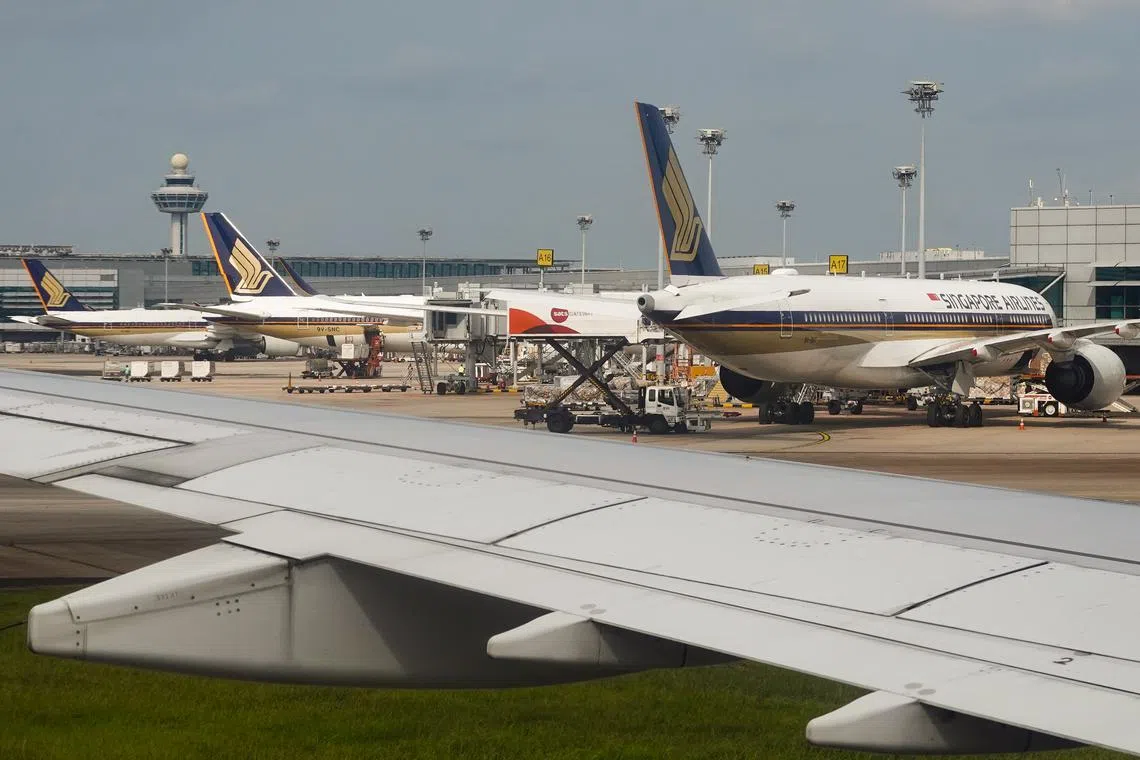More support needed for Singapore to adopt greener jet fuel on wider scale, trial shows
Sign up now: Get ST's newsletters delivered to your inbox

Eco-friendly jet fuel has been touted as the most promising near-term solution to reduce the aviation sector’s carbon emissions.
ST PHOTO: LIM YAOHUI
Follow topic:
SINGAPORE – A trial to supply Singapore Airlines (SIA) and Scoot flights departing from Changi Airport with a more eco-friendly blend of jet fuel has shown that more needs to be done to support wider adoption here.
This is despite the trial showing that Singapore is operationally ready to switch from regular jet fuel to fuel made from waste materials
In a statement last Thursday, the Civil Aviation Authority of Singapore (CAAS), SIA and Temasek-owned investment platform GenZero – the parties involved in the trial – flagged the need for more education, outreach, corporate support and help through government policy.
CAAS said it will include lessons from the trial in its Sustainable Air Hub Blueprint,
The authority said this will allow it to consider developments from an International Civil Aviation Organisation conference in late November in Dubai, where sustainable aviation fuel policies, regulatory frameworks and financing will be discussed.
The blueprint will outline carbon emission reduction goals for Singapore’s aviation sector.
In response to queries from The Straits Times, CAAS director-general Han Kok Juan said the global adoption of sustainable aviation fuel is still in its early stages, and broadening it requires effort from the entire aviation community.
Meanwhile, more work is needed in Singapore to raise awareness about the use of sustainable aviation fuel credits as a tool to reduce carbon footprints, he added.
In the trial by CAAS, SIA and GenZero, which began in February 2022 and has since ended, about two-thirds of the 1,000 credits generated from SIA’s purchase of 1,000 tonnes of sustainable jet fuel were sold.
Each of the 1,000 credits represents a reduction of 2.5 tonnes of carbon dioxide emissions, thus corresponding to about 2,500 tonnes of reductions in all.
The idea was that SIA customers – including corporate and individual travellers as well as freight forwarders – would buy these credits to offset their carbon footprint while contributing to the development of Singapore’s sustainable aviation fuel industry.
With greener jet fuel costing three to five times the price of conventional aviation fuel, the sale of such credits is one way airlines and the aviation authorities hope to defray the higher costs.
SIA had marketed the credits by conducting corporate webinars and one-on-one engagements.
Asked about the factors hindering demand for such credits, Mr Han said they are relatively new and corporate awareness is low.
Moreover, global accounting frameworks for such credits are still being developed and harmonised, and the cost of using greener jet fuel to lower carbon emissions is higher than using other carbon offsets, he added.
SIA was unable to reveal the parties who bought the credits, citing commercial sensitivities.
Mr Han said CAAS is looking into ways to build a marketplace for sustainable aviation fuel credits. It is also considering policy moves to drive demand and incentivise investments in producing such fuels.
It was previously reported that rules mandating or incentivising the use of sustainable aviation fuel
Eco-friendly jet fuel has been touted as the most promising near-term solution to reduce the aviation sector’s carbon emissions.
Finnish biofuel producer Neste supplied the greener fuel that SIA bought as part of the trial.
CAAS, SIA and GenZero said the trial showed sustainable aviation fuel can be deployed safely at Changi Airport without modification to airport infrastructure.
When asked, the parties did not state the ratio of sustainable to conventional fuel that was used. Current aircraft engines can use blends with up to 50 per cent sustainable fuel.
Plans are afoot for more sustainable fuel blends to be used at Changi Airport, with SIA chief executive Goh Choon Phong saying in May that the airline was in talks to buy more.
In October, Dubai-based airline Emirates inked a deal with Neste for the supply of more than 11 million litres of blended sustainable aviation fuel for its flights leaving Changi Airport and Amsterdam’s Schiphol Airport in 2024 and 2025.
Ms Marissa Lee, an associate director at policy advisory firm Global Counsel, said demand for greener jet fuel is set to increase as companies begin to understand its importance in reducing their indirect emissions from business travel.
The higher cost of sustainable aviation fuel is, however, problematic for airlines, since most of their customers still value affordability over environmental sustainability, she said.
Even so, the cost can be lowered if greener jet fuel is produced on a larger scale as demand increases, Ms Lee added.
In 2022, sustainable aviation fuel formed less than 0.1 per cent of global jet fuel consumption.
Mr Sharad Somani, partner and head of infrastructure at KPMG Asia-Pacific, said the rising number of sustainable aviation fuel trials and commitments from airlines in Asia-Pacific is a good sign.
He noted that Asia has an advantage, since much of the raw materials for sustainable jet fuel comes from this part of the world.
“Singapore has the potential to play a leadership role in driving policy, procurement, production and pricing of sustainable aviation fuel within Asean,” he added.


